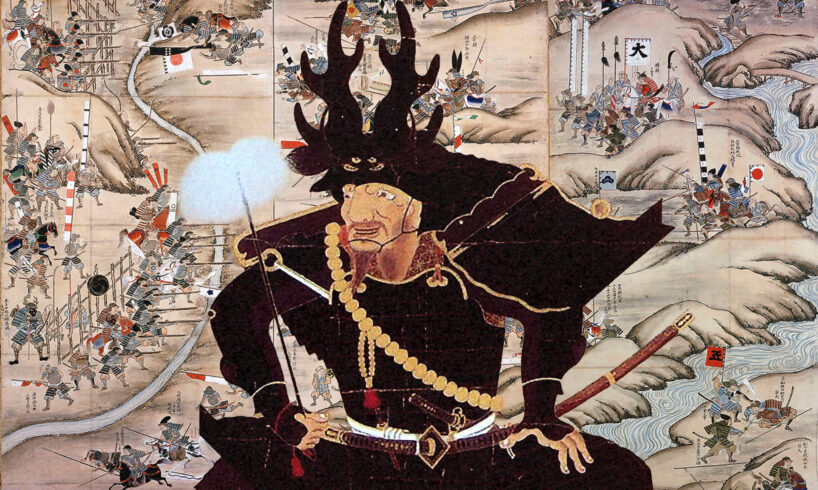
There’s an interesting thing you start to notice while studying paintings depicting Japan’s most famous battles from the 16th century. A lot of them seem to feature a samurai with deer antlers throwing himself into the fray with a look of fierce determination on his face. Who is this frightful figure? The personification of death? The Japanese devil perhaps? It was actually a real guy named Honda Tadakatsu.
He was a veteran of nearly 60 battles during which he reportedly received no serious wounds. He may not have been the devil, but all signs point to him having made a deal with one.
Portrait of Honda Tadakatsu, Chiba Prefectural Central Museum collections (c. 17th century)
Tokugawa Ieyasu’s Ride or Die
Honda Tadakatsu was born in Mikawa Province in modern-day Aichi Prefecture to a clan that served the Matsudaira, who by then were split, surrounded by more powerful enemies and lacked military power or prestige. Tadakatsu, though, didn’t concern himself with such things.
He decided to stay loyal to the young head of the family, Matsudaira Motoyasu, for the rest of his life. This turned out to be an excellent decision since Motoyasu later became Tokugawa Ieyasu, the third great unifier of Japan who ended the Warring States period and created a military government that would rule the country for over 250 years.
Ieyasu probably couldn’t have done it without the help of Tadakatsu, who rode out into battle for him over 50 times and even changed his faith after the followers of his preferred school of Buddhism started opposing and fighting his lord. His loyalty, though, wasn’t the reason why historians named him one of the Four Heavenly Kings of the Tokugawa. It was because of his skills on the battlefield.
Image from The Battle of Nagashino folding screen (c. 18th century) with Honda Tadakatsu highlighted on the lower left
A Revered Warrior and Skilled Administrator
Tadakatsu allegedly participated in his first battle at just 13 and killed his first man when he was 14. Legend goes that his uncle offered to let him decapitate a man he’d just killed, but Tadakatsu was not interested in secondhand glory, so he charged the enemy and came back with a head of his own.
Ieyasu noticed his talents and continued to promote him from soldier to vanguard commander to head of a cavalry unit and, ultimately, general. Tadakatsu more than earned the role. During the Battle of Anegawa in 1570, he fought a one-on-one duel with the gigantic figure of Magara Naotaka, who wielded an equally massive odachi sword.
Three years later, Tadakatsu protected Ieyasu’s retreat from the army of the legendary warrior Takeda Shingen (and specifically one unit led by Naito Masatoyo) after their loss at the Battle of Mikatagahara, saving his lord’s life. This was also when Ieyasu allegedly received a dressing down from an innkeeper for not paying his bills and soiled his britches during the escape.
Tadakatsu would have his revenge during the Battle of Nagashino in 1575, where he commanded a unit of musketeers that helped decimate Takeda’s forces and captured the first enemy general of the day: Masatoyo. Because Tadakatsu does not forgive nor forget.
Of course, he was also there during the famous Battle of Sekigahara in 1600, a decisive victory for Ieyasu, which effectively secured his dominance over Japan. During the conflict, Tadakatsu distinguished himself thanks to his strategies and battlefield bravery. He was subsequently made lord of Kuwana Castle.
Tadakatsu turned out to be as skilled an administrator as he was a warrior, developing the area around the castle through public works and creating a prosperous post-town. He retired in 1609 and died peacefully the following year.
Discover Tokyo, Every Week
Get the city’s best stories, under-the-radar spots and exclusive invites delivered straight to your inbox.
A Stylish Samurai
During the Battle of Komaki and Nagakute in 1584, Toyotomi Hideyoshi (Ieyasu’s chief rival at the time) had a chance to attack and almost certainly kill Tadakatsu, but ordered his troops to leave him be because he thought it would be a waste to dispose of one of the bravest samurai in Japan.
Even Oda Nobunaga, the Demon King himself, had a lot of respect for him. This was mainly due to his skills on the battlefield, though his distinctive attire also didn’t hurt his reputation.
Tadakatsu had a few different battle banners, including one depicting Shoki the Demon Queller, a powerful guardian deity. He also wielded the Tonbogiri (dragonfly-cutter) spear, considered one of the Three Great Spears of Japan, which was said to be sharp enough to cut a dragonfly in two if it landed on it.
His other weapon was the Nakatsukasa sword by Masamune, the greatest swordsmith in Japanese history. Also rarely missing from Tadakatsu’s getup was a large Buddhist rosary that he often slung over his shoulder during battles. But his most distinguishing feature was his helmet with massive deer antler crests.
Deer are powerful symbols in Japanese mythology. They’re said to be messengers of Amaterasu, the goddess of the Sun and arguably the most important deity in the Shinto pantheon. And because deer shed and regrow their horns, antlers are sometimes considered symbols of death and rebirth.
Tadakatsu was usually associated with the former. But what an honor to be killed by a warrior of such caliber. Honestly, all of his victims on the battlefield would probably have thanked him if they hadn’t had their heads cut off.





